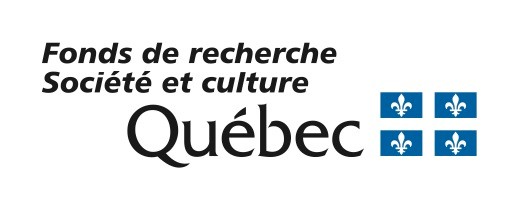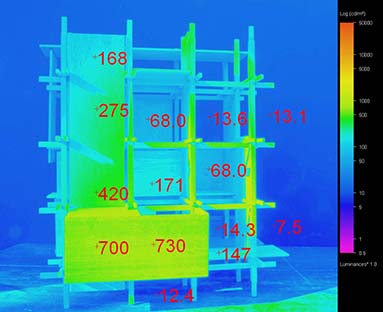L’Oeil Créatif
The Creative Eye | a digital process exploring visual and thermal diversity in architecture
Subvention de recherche-création /Research Grant, FQRSC (Fonds Québécois pour la recherche sur la société et la culture). 2008-2012
This research proposes to explore the environmental diversity stemming from the combination of visual and thermal perception of light through a digital design process. Starting from previous theoretical transitional typologies defined by Potvin [1999], the research will first identifies existing structures corresponding to these basic typologies to feed the creative design process. The library of images will consist of typologies that will play “a creative role by allowing the designer to begin the cycle of analysis and revision from a reasonably confident position” [Hawkes, 1976] to develop space and light explorations. The videosketchbook approach, a digital design methodology developed by Demers [1997, 2003, 2006] for lighting design will be expanded to encompass thermal imagery and used as a design tool throughout the research program.
Claude MH Demers and André Potvin

Context of implementation of the research-creation program
Today’s sustainable challenge in architecture greatly depends upon the architects’ ability to optimise the energy performance of buildings. This energy performance rests fundamentally on two aspects: the correct definition of the interior-exterior transition in terms of opacity and transparency and the comfort expectation of the occupants. Transitional spaces, which are neither inside nor outside, could therefore optimize the free energy transactions of light, heat, and air between the exterior ambient environment and the interior while increasing the occupants’ adaptation through environmental diversity. Recent developments in energy simulation modelling have significantly contributed to the quantitative evaluation of daylighting and solar strategies and yet, very few researchers have explored the combined visual and thermal qualitative aspects of light. This lack of visual and thermal literacy often leads to major incompatibility in terms of environmental comfort and deceiving energy performance. The integration of the visual and thermal qualities of light in buildings are fundamental and should be part of the architect’s basic skills in the creation of responsive environmental design.
Architects are already taking advantage of the recent development of digital technology but they still tend to rely mainly on post-design simulation of their project for validation purposes. Digital technology should rather be integrated throughout the design process to encourage the qualitative creative inquiry. Digital imagery, with its inherent qualitative perceptual values and its quantitative pixelated content offer an integrated medium for the study of physical ambiences in in situ analysis or more speculative explorations through scale models.
This research will explore the environmental diversity stemming from the combination of visual and thermal perception of light through a digital design process. Starting from previous theoretical transitional typologies defined by Potvin [1999], the research will first identify existing structures corresponding to these basic typologies to feed the creative design process. The library of images will consist of typologies that will play ‘a creative role by allowing the designer to begin the cycle of analysis and revision from a reasonably confident position’ [Hawkes, 1976] in the development of space and light explorations. The videosketchbook approach, a digital design methodology developed by Demers [1997, 2003, 2006] for lighting design will be expanded to encompass thermal imagery and used as a design tool throughout the research program.
Objectives pursued by research-creation approach
General
- Development of the theory and practice of environmental diversity in architecture
- Creation of a typology of lighting and thermal ambiences based on a visualisation approach that integrates visual and tactile experiences
- Initiation of a creative and interactive design process between the qualitative and quantitative aspects of lighting and thermal aspects of architecture using a digital method of image analysis
Specific
- Integration of thermal imaging technology to the digital method of image analysis developed by Demers [1991-2007] for the visualisation of light in architecture
- Association of typologies of transitional spaces developed by Potvin [1999] with analysed architectural precedents to integrate a discussion of lighting and thermal ambiences
- Exploration of the potential of transitional typologies based on an empirical knowledge built from the design method using a tactile and digital process of imagining architectural spaces
Impact of the research-creation program on the development or renewal of architecture
The Creative Eye proposes to contribute to the renewal of architecture by using digital images as starting points of the design process in order to reinvest our experience of space with rich visual and thermal stimuli instead of the current mono functionality derived from the deterministic approach to environmental science.
References
Bracarense, Viana Junior, Da Silva Jota, Sad De Assis, (2002), “Public building lighting performance analysis”, PLEA 2002 (Passive Low Energy in Architecture): Design with the environment, Proceedings of the 19th International Conference, Toulouse, France, July, p. 821-825.
DEMERS, C., (2007), « The Creative Eye: A tactile and digital process of imagining and building lights in architecture », in « Fresh air », Proceedings of the 2007 Association of Collegiate Schools of Architecture (ACSA) 95th Annual Meeting in Philadelphia, 8-11 March. Paper selected from the ACSA 2006 Northeastern Conference.
DEMERS, C, (2007), « A Classification of daylighting qualitites based on contrast and brightness analysis », in the Conference Proceedings of the American Solar Energy Society (ASES), SOLAR 2007, 7-12 July, Cleaveland, Ohio.
DEMERS, C., (2006), “Assessing light in architecture: A numerical procedure for a qualitative and quantitative analysis”, dans les actes de colloque de , l’Italian Lighting Association (AIDI), Commission Internationale de l’Éclairage (CIE), Venise, 9-10 octobre 2006.
DEMERS, POTVIN, (2004), “Physical ambiences in architecture : towards a multi-sensory approach to sustainability”, Department of Architecture, University of Cambridge, Cambridge, UK, 5 mai
DEMERS, C., (2000), “Light and the digital image : a proposed framework for design and analysis” dans Architecture City Environment, Proceedings of PLEA 2000, July 2000, Cambridge, United Kingdom. Éditeurs : Koen Steemers and Simos Yannas. James and James Science Publishers, London, 2000.
DEMERS, (1997), “The Sanctuary of art : images in the design and assessment of light in architecture”, The Martin Centre for Architectural and Urban Studies, University of Cambridge, UK.
HAWKES, Dean U., (1976), “Types, norms and habits in environmental design” in March, Lionel, The architecture of form, Cambridge University Press, Cambridge, pp. 465-481. . (Also in “The Environmental Tradition”).
POTVIN, A., BONTEMPS, A., DEMERS, C. (2007), “The Dynamics of Physical Ambiences, Development of a Representation Technique Through a Filmic and Sensory Approach”, ACADIA2007 Conference-Expanding Bodies, Halifax, 1-7 octobre 2007.
POTVIN, A. (2004), “Chapitre 5 : Intermediate Environments”, dans Environment and Diversity, Koen Steemers Ed., E&F Spon Press, London.
POTVIN, DEMERS, DUBOIS, (2004), “Environmental Adaptability in architecture: towards a dynamic multi-sensory approach integrating user’s behaviour”, Proceedings of Windsor2004, Windsor Conference on POEs, 29 avril-2 mai 2004: Closing the loop : Post-occupancy evaluation.
POTVIN, A. (2002) “L’intérieur-extérieur”, Exposition publique des résultats d’une bourse aux artistes professionnels du CALQ (Conseil des arts et des lettres du Québec), École d’architecture, 21 mars-11 avril 2002.
POTVIN, A. (2002), ”A Combined Quantitative and Qualitative Approch to Comfort”, dans les Actes de PLEA2002 (Passive Low-Energy Architecture, Toulouse, Juillet 2002.
Siret, D., “Proposition pour une approche déclarative des ambiances dans le projet architectural: application à l’ensoleillement”, PhD thesis, (1997), Université de Nantes, France.
Schiler, Marc, (2000), “Towards a Definition of Glare: Can qualitative issues be quantified?”, 2nd EAAE-ARCC Conference on Architectural Research, July 4-8, Paris, France.


